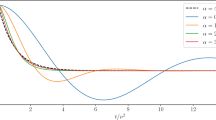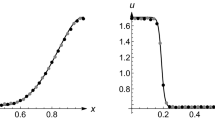Abstract
In this paper, we discuss a possible generalization of the social influences of the Langevin equation. Using a functional method of the Kramers–Moyal expansion coefficients, we prove a simple rule for the corresponding Fokker–Planck equation for a generalized one-dimensional system driven by associated Gaussian noise. We propose here a generalization of the nonequilibrium behavior of the probability density and probability currents induced by different combinations of parameters. In addition, it is interesting to find that the probability of current transport reversal can be obtained by varying the combination of parameters, but the amplitude of the negative and positive currents is controlled by adjusting the interaction coefficient and the intensity factor of the outfield, respectively.








Similar content being viewed by others
Data Availability Statement
Data sharing is not applicable to this article as no datasets were generated or analyzed during the current study.
References
Serge Galam, Sociophysics: Cosmos and Chaos in Nature and Culture (Springer, US, 2012)
Parongama Sen, Bikas K. Chakrabarti, Sociophysics: An Introduction (Oxford University Press, Oxford, 2013)
Claudio Castellano, Santo Fortunato, Vittorio Loreto, Statistical physics of social dynamics. Rev. Mod. Phys. 81(2), 591–646 (2009)
Amit K. Chattopadhyay, Memory effects in a nonequilibrium growth model. Phys. Rev. E 80(1), 011144 (2009)
M.A.A. da Silva, J.C. Cressoni, Gunter M. Schutz et al., Non-Gaussian propagator for elephant random walks. Phys. Rev. E 88(2), 022115 (2013)
Hiroaki Hara, Generalization of the random-walk process. Phys. Rev. B 20(10), 4062–4068 (1979)
Gunter M. Schutz, Steffen Trimper, Elephants can always remember: Exact long-range memory effects in a non-Markovian random walk. Phys. Rev. E 70(4), 045101(R) (2004)
E.T. Jaynes, Bretthorst G. Larry, Probability theory: the logic of science (Cambridge University Press, UK, 2003)
Ernest George Ravenstein, The laws of migration. J. Stat. Soc. London 48(2), 167–235 (1885)
Rudolph Heberle, The causes of rural-urban migration a survey of german theories. American J. Sociol. 43(6), 932–950 (1938)
George Kingsley Zipf, The P1 P2/D hypothesis: on the intercity movement of persons. American Sociol. Rev. 11(6), 677–686 (1946)
Tao Zhou, Xiaopu Han, Xiaoyong Yan et al., Statistical mechanics on temporal and spatial activities of human. J. Univ. Electron. Sci. Technol. China 42(4), 481–540 (2013)
Guillem Mosquera-Doñate, Marián Boguñá, Follow the leader: Herding behavior in heterogeneous populations. Phys. Rev. E 91(5), 052804 (2015)
Katarzyna Sznajd-Weron, Józef. Sznajd, Opinion evolution in closed community. Int. J. Mod. Phys. C 11(06), 1157–1165 (2000)
K. Sznajd-Weron, R. Weron, A simple model of price formation. Int. J. Mod. Phys. C 13(01), 115–123 (2002)
D. Stauffer, A.O. Sousa, S. Moss de Oliveira, Generalization to square lattice of sznajd sociophysics model. Int. J. Mod. Phys. C 11(06), 1239–1245 (2000)
B. During, P. Markowich, J.-F. Pietschmann et al., Boltzmann and Fokker-Planck equations modelling opinion formation in the presence of strong leaders. Proc. Royal Soc. A: Math. Phys. Eng. Sci. 465(2112), 3687–3708 (2009)
J.S. Bader, R.W. Hammond, S.A. Henck et al., DNA transport by a micromachined Brownian ratchet device. Proc. Nat. Acad. Sci. 96(23), 13165–13169 (1999)
Tianshou Zhou, Luonan Chen, Kazuyuki Aihara, Molecular Communication through Stochastic Synchronization Induced by Extracellular Fluctuations. Phys. Rev. Lett. 95(17), 178103 (2005)
Martin Bier, Astumian R. Dean, Biasing Brownian motion in different directions in a 3-State fluctuating potential and an application for the separation of small particles. Phys. Rev. Lett. 76, 4277–4280 (1996)
Astrid Haljas, Romi Mankin, Ako Sauga et al., Anomalous mobility of Brownian particles in a tilted symmetric sawtooth potential. Phys. Rev. E 70(4), 41107–41107 (2004)
Chunhua Zeng, Hua Wang, Yonggang Wei et al., Anomalous transport controlled via potential fluctuations. Phys. A: Stat. Mech. Appl. 392(11), 2623–2630 (2013)
A. La Cognata, D. Valenti, A.A. Dubkov et al., Dynamics of two competing species in the presence of Lévy noise sources. Phys. Rev. E 82(1), 011121 (2010)
Keiko Yokoyama, Hiroyuki Shima, Keisuke Fujii et al., Social forces for team coordination in ball possession game. Phys. Rev. E 97(2), 022410 (2018)
Sébastian. Grauwin, Pablo Jensen, Opinion group formation and dynamics: Structures that last from nonlasting entities. Phys. Rev. E 85(6), 066113 (2012)
Basil S. Bayati, Deterministic analysis of extrinsic and intrinsic noise in an epidemiological model. Phys. Rev. E 93(5), 052124 (2016)
Dirk Helbing, Péter. Molnár, Social force model for pedestrian dynamics. Phys. Rev. E 51(5), 4282–4286 (1995)
D. Helbing, I. Farkas, T. Vicsek, Simulating dynamical features of escape panic. Nature 407(6803), 487–490 (2000)
G. Köster, F. Treml, M. Gödel, Avoiding numerical pitfalls in social force models. Phys. Rev. E 87(6), 063305 (2013)
Guillaume Deffuant, David Neau, Frederic Amblard et al., Mixing beliefs among interacting agents. Adv. Complex Syst. 03, 87–98 (2000)
M. Suman Kalyan, G. Anjan Prasad, V.S.S. Sastry et al., A note on non-equilibrium work fluctuations and equilibrium free energies. Phys. A: Stat. Mech. Appl. 390(7), 1240–1247 (2011)
Trieu Mai, Abhishek Dhar, Nonequilibrium work fluctuations for oscillators in non-Markovian baths. Phys. Rev. E 75(6), 061101 (2007)
Ushnish Ray, Garnet Kin-Lic. Chan, David T. Limmer, Exact fluctuations of nonequilibrium steady states from approximate auxiliary dynamics. Phys. Rev. Lett. 120(21), 210602 (2018)
Yinxia Han, Jinghui Li, Shigang Chen, Effect of asymmetric potential and gaussian colored noise on stochastic resonance. Commun. Theor. Phys. 44(8), 226–230 (2005)
Hannes Risken, Fokker-Planck Equation for Several Variables; Methods of Solution. (Springer, Berlin Heidelberg, 1996), 44(8), 133–162
Horst Siebert, Economic Growth and Environmental Quality. (Springer, Berlin Heidelberg, 1992) 8, 233–247
Emil Georgiev, Emil Mihaylov, Economic growth and the environment: reassessing the environmental Kuznets Curve for air pollution emissions in OECD countries. Lett. Spat. Resour. Sci. 8(1), 29–47 (2014)
Victor Brajer, Robert W. Mead, Feng Xiao, Health benefits of tunneling through the Chinese environmental Kuznets curve (EKC). Ecol. Econ. 66(4), 674–686 (2008)
Abid Rashid Gill, Kuperan K. Viswanathan, Sallahuddin Hassan, The environmental kuznets curve (EKC) and the environmental problem of the day. Renew. Sustain. Energy Rev. 81(4), 1636–1642 (2018)
Dimitra Kaika, Efthimios Zervas, The environmental kuznets curve (EKC) theory. Part B: Crit. Issues Energy Policy 62, 1403–1411 (2013)
P.P. Li, P.M. Hui, Dynamics of opinion formation in hierarchical social networks: Network structure and initial bias. Eur. Phys. J. B 61(3), 371–376 (2008)
André A. Moreira, Demétrius R. Paula, N. Raimundo et al., Competitive cluster growth in complex networks. Phys. Rev. E 73(6), 065101 (2006)
Angel Stanoev, Daniel Smilkov, Ljupco Kocarev, Identifying communities by influence dynamics in social networks. Phys. Rev. E 84(4), 046102 (2011)
Sung-Guk. Han, Jaegon Um, Beom Jun Kim, Voter model on a directed network: Role of bidirectional opinion exchanges. Phys. Rev. E 81(5), 057103 (2010)
V. Schwammle, M.C. González, A.A. Moreira et al., Different topologies for a herding model of opinion. Phys. Rev. E 75(6), 066108 (2007)
V.A. Avetisov, A.V. Chertovich, S.K. Nechaev et al., On scale-free and poly-scale behaviors of random hierarchical networks. J. Stat. Mech. Theory Exp. 2009(07), P07008 (2009)
Hanyin Xia, Jinghui LI, Chenshi Gang, Flux for a system with infinite globally coupled oscillators driven by temporal-spatial noises. Commun. Theor. Phys. 40(12), 665–668 (2003)
Hermann Haken, Synergetics (Springer, Berlin Heidelberg, 1983)
C. Van den Broeck, Thermodynamic efficiency at maximum power. Phys. Rev. Lett. 95(15), 190602 (2005)
J.M. Sancho, M. Miguel, D.. Dürr. San, Adiabatic elimination for systems of Brownian particles with nonconstant damping coefficients. J. Stat. Phys. 28(2), 291–305 (1982)
G. Szabó, Tânia. Tomé, István Borsos, Probability currents and entropy production in nonequilibrium lattice systems. Phys. Rev. E 82(1), 011105 (2010)
Roland Bartussek, Peter Reimann, Peter Hnggi, Precise Numerics versus Theory for Correlation Ratchets. Phys. Rev. Lett. 76(7), 1166–1169 (1996)
Marcelo O. Magnasco, Forced thermal ratchets. Phys. Rev. Lett. 71, 1477–1481 (1993)
N.V. Agudov, A.N. Malakhov, Decay of unstable equilibrium and nonequilibrium states with inverse probability current taken into account. Phys. Rev. E 60(6), 6333–6342 (1999)
A. Lubk, A. Béché, J. Verbeeck, Electron Microscopy of Probability Currents at Atomic Resolution. Phys. Rev. Lett. 115(17), 176101 (2015)
M.J. Kazemi, H. Hashamipour, M.H. Barati, Probability density of relativistic spinless particles. Phys. Rev. A 98(1), 012125 (2018)
Shigang Chen, Non-equilibrium statistical mechanics (Science press, Beijing, 2010)
P. Reimann, C.V.D. Broeck, R. Kawai, Nonequilibrium noise in coupled phase oscillators. Phys. Rev. E 60, 6402–6406 (1999)
P. Reimann, R. Kawai, C. Van den Broeck et al., Coupled Brownian motors: Anomalous hysteresis and zero-bias negative conductance. Europhys. Lett. 45(5), 545 (1999)
Tianfu Gao, Jincan Chen, The current transport characteristics of a delayed feedback ratchet in a double-well potential. J. Phys. A: Math. Theor. 42(6), 065002 (2009)
G.A.O. Tianfu, Yue Zhang, Jincan Chen, The current characteristics of two-state flashing ratchets composed of two asymmetric potentials. Mod. Phys. Lett. B 22(30), 2967–2978 (2008)
Suman Kalyan Maity, T. Venkat Manoj, Animesh Mukherjee, Opinion formation in time-varying social networks: The case of the naming game. Phys. Rev. E 86, 036110 (2012)
Feng Shi, Peter J. Mucha, Richard Durrett, Multiopinion coevolving voter model with infinitely many phase transitions. Phys. Rev. E 88, 062818 (2013)
William Pickering, Chjan Lim, Solution of the multistate voter model and application to strong neutrals in the naming game. Phys. Rev. E 93, 032318 (2016)
Acknowledgements
This work was supported by the National Natural Science Foundation of China (12001015 and 11861003), the Natural Science Foundation of Ningxia (2021AAC03206), the First-Class Disciplines Foundation of Ningxia in China (Grant No. NXYLXK2017B09).
Author information
Authors and Affiliations
Corresponding author
Ethics declarations
Conflict of interest
The authors declare that they have no competing interests.
Rights and permissions
About this article
Cite this article
Dong, J., Li, C., Wang, P. et al. Non-equilibrium diffusion characteristics of the particles system and its application. Eur. Phys. J. Plus 137, 874 (2022). https://doi.org/10.1140/epjp/s13360-022-03049-z
Received:
Accepted:
Published:
DOI: https://doi.org/10.1140/epjp/s13360-022-03049-z




